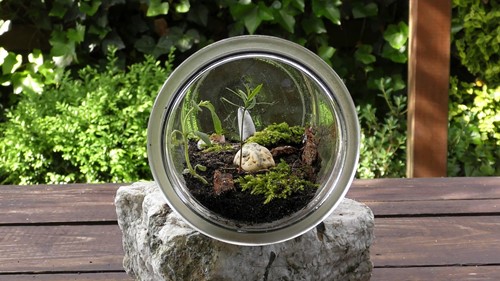
Image by AndyFaeth from Pixabay
If you're searching for ways to introduce a little extra green into your home and at the same time learn a satisfying hobby consider building a terrarium.
Putting together a terrarium is a learning experience for grown-ups and can draw in kids as well. Not only do you see your handiwork grow and thrive, but you’ll observe a real-life example of a working ecosystem. A terrarium, if it’s a closed one, recycles its oxygen, carbon dioxide and water.
In simplest terms, it’s a glass container for growing plants. There’s a variation called a vivarium, a similar construction with small animals, but plants are a great starting point.
Terrariums (either “terrariums” or “terraria” is an acceptable plural) can be either open or closed. Open terrariums are better for plants that can’t tolerate moisture buildup.
First, find a glass container. For a closed terrarium, any glass container with a removable lid will work. You can order one or find one around the house. It could be a rectangular glass box with a top or a rounded jar with a stopper. A Mason jar, either upright or on its side. A covered fishbowl. A cookie or candy jar. You can also use plastic if it’s clear and resists fogging.
Lay down a base. Use rocks, plain or colored gravel, seaglass or other decoratives. This is your drainage layer. It should be about an inch deep, but that can vary depending on the size and shape of your container. The finished product will need enough “headroom” for your little garden. The base layer doesn’t have to be flat; you may shape it to create peaks and valleys.
Some sources recommend a ½ inch layer of charcoal next as a water filtrate.
Create a barrier for your soil with sphagnum or sheet moss. Soak it briefly, squeeze out the water and mold it into place.
Add about two inches of soil. Common potting soil is good for most plants. If your gravel layer is flat your can shape this to make miniature hills and valleys.
Now you’re ready to plant. Use slow growing vegetation and dwarfs. Peperomia, ferns (maidenhead, button ferns), pilea and dwarf palms are good choices, as well as miniature coleus, violets, begonias. There are suitable lichens and mosses.
As for maintenance, there’s not much. After an initial watering, you have only to keep it moist. For a closed system, which recycles water, a light mist every few weeks is adequate. Once a week, briefly remove the cover to rebalance the air. Trim plants to keep them small. Terrariums do best in indirect sunlight. The glass can magnify direct rays.

I am experienced creative thinking REALTOR, Dedicated to my clients, both sellers and buyers. Licensed in IL 1974-2014. Florida Broker with Sun Realty USA in Naples/Ft Myers FL since 2004 with $80 Million in Florida sales.
Assisting my customers with honest answers to meet their real estate needs. Specializing in the resort lifestyle communities in Naples, Bonita Springs, Estero, and Ft Myers of SW FLORIDA.
Jay Siegall, your friend, your neighbor, YOUR REALTOR.
Let me help you to make your best deal on the best property to meet your lifestyle and budget.